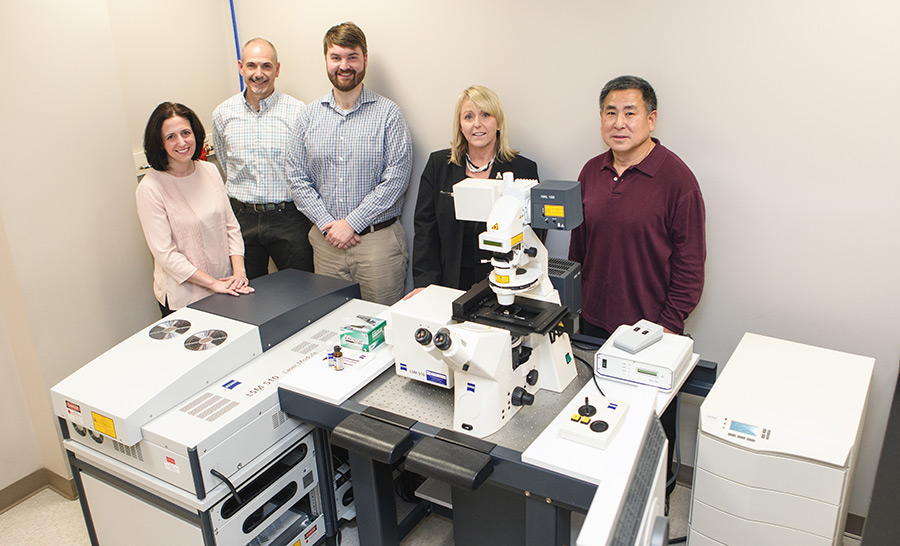BOONE, N.C.—Appalachian State University’s William C. and Ruth Ann Dewel Microscopy Facility has received a $430,900 award from the National Science Foundation (NSF) to purchase a new state-of-the-art laser scanning confocal microscope (LSM).
LSM is an essential tool for studying cell and gene function in animals, plants and microorganisms. The new LSM will improve the quality and expand the scope of the research, training and educational activities in several scientific disciplines at Appalachian, especially for biology and chemistry.
The new microscope will replace Appalachian’s current LSM 510, which was purchased with a NSF award in 2004.
“It is very exciting that we will have the newest generation of LSM at Appalachian soon,” said Dr. Guichuan Hou, the director of the microscopy facility.
Hou said that the new microscope has two features that Appalachian’s current confocal microscopes lack: a 405 nm laser and Airyscan. The 405 nm laser has more power and will extend Appalachian’s choices for fluorescent dyes, such as for DNA labeling. The Airyscan greatly increases signal-to-noise ratio of fluorescence imaging and decreases photo bleaching. This is very important for live cell imaging because of the improved signal detection and reduced photo damage.
Hou led a team that wrote the grant proposal together. The team included three faculty members from the Department of Biology: Dr. Ted Zerucha, Dr. Sue Edwards and Dr. Andrew Bellemer, as well as Dr. Jennifer Cecile from the Department of Chemistry.
Bellemer will use the microscope to enhance his study of the morphology and function of sensory neurons in the fruit fly (Drosophila melanogaster), capitalizing on several of the microscopes features, including improved resolution and faster scan speeds.
“Much like humans, fruit flies possess sensory neurons that they use to detect hazards in their environment, such as elevated temperature or noxious chemicals, and then execute behavioral responses to avoid these hazards,” Bellemer said. Identifying these mechanisms may provide general insight into how organisms detect such environmental hazards as changing temperatures and behave in response. Additionally, the cellular and molecular mechanisms that biologists identify may provide insight into the pathogenesis of chronic pain in humans and animals.
As for Cecile, the microscope will enhance her study of anion transporters, proteins that facilitate the absorption, distribution and elimination of substances such as pharmaceuticals, hormones and toxins in the body. She said that the microscope will help her learn more about the structures of anion transporters and how their conformational changes allow substances to pass through cellular membranes. This information is crucial to pharmaceuticals being designed in such a way that they include critical structural features for absorption, distribution and elimination to occur.
As for Edwards, her research is focused on examining the evolution of cellular mechanisms associated with ridding the body of waste products. She works on a unique class of fishes, namely the jawless fish, hagfishes and lampreys that have an ability to tolerate a wide range of internal and external environmental concentrations.
“The new microscope will enable us to answer fundamental questions regarding the location and function of cellular mechanisms associated with waste excretion,” she said.
“The aim is to develop a clearer insight into the factors explaining why hagfishes and lampreys have persisted for over 500 million years as the only surviving members of the basal vertebrate class Agnatha.”
As for Zerucha, he will use the microscope to study the regulation of gene expression during embryonic development and how these regulatory mechanisms have evolved. The Zerucha lab studies cis-regulatory elements that are also known as enhancers, using zebrafish as a model system. These are often very well conserved regions of DNA that are associated with genes and that control when and where that gene is active in an organism.
During embryonic development the regulation of gene expression is tightly controlled and changes in gene expression can lead to birth defects as well as diseases such as cancer. In addition, it is thought that changes in the regulation of gene expression have played a major role in the evolution of animal diversity.
To study these cis-regulatory elements, the Zerucha lab places the gene encoding the Green Fluorescent Protein (GFP) adjacent to them. The cis-element is then able to direct GFP expression, which can be visualized in developing zebrafish embryos using the new confocal microscope. The improved scan speed and resolution of the new confocal microscope allows the visualization of GFP expression in individual neurons of the developing central nervous system as well as muscle fibers in living zebrafish embryos that only a few millimeters in length.
Hou said that many other faculty members will use the new LSM for their teaching and research. For example, Dr. Mark Venable, a professor of biology, and Dr. Darren Seals, an assistant professor of biology, will use it for Cell Biology labs. Dr. Ece Karatan, a professor of biology, will use it to study biofilm formation. And Dr. Cortney Bouldin, an assistant professor of biology, will use it for his developmental biology research with zebrafish.
“It is very important that we keep using the microscope in many different, positive ways and continue to impact our faculty and staff research, student and graduate student training, and community outreach,” Hou said. “I deeply appreciate NSF and the College of Arts and Sciences for their continuous support of the microscopy facility at Appalachian.”
About Appalachian State University
As a premier public institution, Appalachian State University prepares students to lead purposeful lives. App State is one of 17 campuses in the University of North Carolina System, with a national reputation for innovative teaching and opening access to a high-quality, cost-effective education. The university enrolls more than 21,000 students, has a low student-to-faculty ratio and offers more than 150 undergraduate and 80 graduate majors at its Boone and Hickory campuses and through App State Online. Learn more at https://www.appstate.edu.
What do you think?
Share your feedback on this story.












